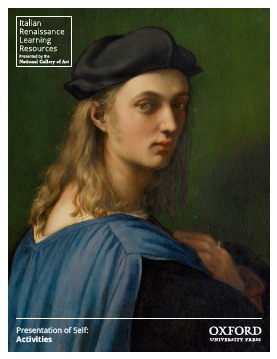
Presentation of Self Activity Guide
The activity guides for each unit contain several activities organized around the theme of the unit. The guides provide detailed instruction and additional materials like figures, worksheets, handouts, or readings for incorporating activities into a classroom setting. Each activity also corresponds with a different academic level (Elementary / Intermediate / Advanced), which is noted next to the title of the activity.
PDF Download: Presentation of Self – Activity Guide
Activities for this unit:
- Celebrating with Ceramics – In the Renaissance, the dishes on which food was served often celebrated marriage alliances, political achievements, or even the owner’s scholarly erudition. In this activity, students design a series of decorative plates that would celebrate major occasions.
- Deciphering a Portrait – A striking portrait by Titian presents a middle-aged gentleman, somberly dressed in black, looking out earnestly at the viewer and prominently displaying a slip of paper on which are written the words: “Di Titiano Vecellio singolare amico” (which can be translated as “Titian’s special friend”). No scholar has yet determined the reasons for the commissioning of the painting or what its function may have been. In this activity, students draw up scripts to account for the patron’s purposes in commissioning and displaying the painting.
- Give me your hand – The joining of right hands as a significant gesture goes back to antiquity and has a Latin name, dextrarum junctio, which literally means “the joining of right hands.” The idea has come down to us in the handshake, which can convey a variety of meanings, from the simple “Glad to see you” to the more complex “‘Til death do us part.” In the Renaissance, marriages could be legalized with the dextrarum juntio.